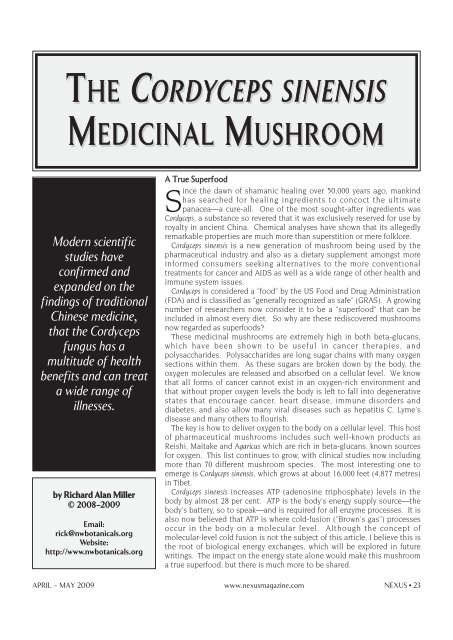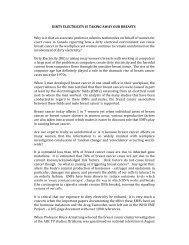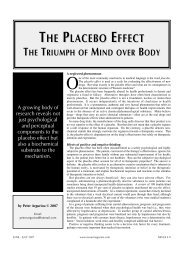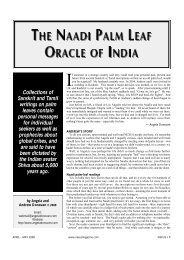the cordyceps sinensis medicinal mushroom - Nexus Magazine
the cordyceps sinensis medicinal mushroom - Nexus Magazine
the cordyceps sinensis medicinal mushroom - Nexus Magazine
- No tags were found...
You also want an ePaper? Increase the reach of your titles
YUMPU automatically turns print PDFs into web optimized ePapers that Google loves.
THE CORDYCEPS SINENSISMEDICINAL MUSHROOMModern scientificstudies haveconfirmed andexpanded on <strong>the</strong>findings of traditionalChinese medicine,that <strong>the</strong> Cordycepsfungus has amultitude of healthbenefits and can treata wide range ofillnesses.by Richard Alan Miller© 2008–2009Email:rick@nwbotanicals.orgWebsite:http://www.nwbotanicals.orgA True SuperfoodSince <strong>the</strong> dawn of shamanic healing over 50,000 years ago, mankindhas searched for healing ingredients to concoct <strong>the</strong> ultimatepanacea—a cure-all. One of <strong>the</strong> most sought-after ingredients wasCordyceps, a substance so revered that it was exclusively reserved for use byroyalty in ancient China. Chemical analyses have shown that its allegedlyremarkable properties are much more than superstition or mere folklore.Cordyceps <strong>sinensis</strong> is a new generation of <strong>mushroom</strong> being used by <strong>the</strong>pharmaceutical industry and also as a dietary supplement amongst moreinformed consumers seeking alternatives to <strong>the</strong> more conventionaltreatments for cancer and AIDS as well as a wide range of o<strong>the</strong>r health andimmune system issues.Cordyceps is considered a "food" by <strong>the</strong> US Food and Drug Administration(FDA) and is classified as "generally recognized as safe" (GRAS). A growingnumber of researchers now consider it to be a "superfood" that can beincluded in almost every diet. So why are <strong>the</strong>se rediscovered <strong>mushroom</strong>snow regarded as superfoods?These <strong>medicinal</strong> <strong>mushroom</strong>s are extremely high in both beta-glucans,which have been shown to be useful in cancer <strong>the</strong>rapies, andpolysaccharides. Polysaccharides are long sugar chains with many oxygensections within <strong>the</strong>m. As <strong>the</strong>se sugars are broken down by <strong>the</strong> body, <strong>the</strong>oxygen molecules are released and absorbed on a cellular level. We knowthat all forms of cancer cannot exist in an oxygen-rich environment andthat without proper oxygen levels <strong>the</strong> body is left to fall into degenerativestates that encourage cancer, heart disease, immune disorders anddiabetes, and also allow many viral diseases such as hepatitis C, Lyme'sdisease and many o<strong>the</strong>rs to flourish.The key is how to deliver oxygen to <strong>the</strong> body on a cellular level. This hostof pharmaceutical <strong>mushroom</strong>s includes such well-known products asReishi, Maitake and Agaricus which are rich in beta-glucans, known sourcesfor oxygen. This list continues to grow, with clinical studies now includingmore than 70 different <strong>mushroom</strong> species. The most interesting one toemerge is Cordyceps <strong>sinensis</strong>, which grows at about 16,000 feet (4,877 metres)in Tibet.Cordyceps <strong>sinensis</strong> increases ATP (adenosine triphosphate) levels in <strong>the</strong>body by almost 28 per cent. ATP is <strong>the</strong> body's energy supply source—<strong>the</strong>body's battery, so to speak—and is required for all enzyme processes. It isalso now believed that ATP is where cold-fusion ("Brown's gas") processesoccur in <strong>the</strong> body on a molecular level. Although <strong>the</strong> concept ofmolecular-level cold fusion is not <strong>the</strong> subject of this article, I believe this is<strong>the</strong> root of biological energy exchanges, which will be explored in futurewritings. The impact on <strong>the</strong> energy state alone would make this <strong>mushroom</strong>a true superfood, but <strong>the</strong>re is much more to be shared.APRIL – MAY 2009 www.nexusmagazine.com NEXUS • 23
What makes Cordyceps important for use with canceris that it contains beta-glucans and polysaccharides.As <strong>the</strong> sugars break down, <strong>the</strong> numerous oxygenmolecules are released on a cellular level, <strong>the</strong> resultbeing that cancerous materials present areimmediately destroyed. Cordycepin, one of <strong>the</strong> targetcompounds (nucleosides), inhibits <strong>the</strong> DNA repairmechanism and is probably responsible for its antiviral(HIV) effects.Full-spectrum ChemistriesThere is a lot of confusion today in <strong>the</strong> field ofpharmaceutical <strong>mushroom</strong>s as towhat form of <strong>mushroom</strong> product is<strong>the</strong> best for use. There are variouscomponents of <strong>the</strong> <strong>mushroom</strong> whichhave been used as separatedcompounds. Is it <strong>the</strong> fruit-body, <strong>the</strong>mycelium or an extract standardisedfrom some particular compoundwhich is responsible for <strong>the</strong><strong>mushroom</strong>'s properties? Thisquestion is not as straightforward asit seems.Fruit body. This is <strong>the</strong> <strong>mushroom</strong>that you see above <strong>the</strong> ground. It is<strong>the</strong> spore- producing portioninvolved with reproduction.Basically, <strong>the</strong> fruit body isequivalent to <strong>the</strong> flower of aplant. Fruit bodies only form inresponse to some stress from<strong>the</strong> environment.Mycelium. This is <strong>the</strong> growthform of <strong>the</strong> organism under <strong>the</strong>ground where all of <strong>the</strong> lifeprocesses occur: growth,feeding, competing for survivaland some forms of reproduction.Broth. In cultivated<strong>mushroom</strong> products, <strong>the</strong> mycelium can be grownei<strong>the</strong>r by fermentation, in a tank full of liquid "broth",or on a solid substrate of some material that is foundin <strong>the</strong> natural growth condition.For <strong>the</strong> production of many <strong>mushroom</strong>-derived drugsand health supplements, <strong>the</strong> compounds are extractednot from <strong>the</strong> mycelium but from <strong>the</strong> broth in which <strong>the</strong>mycelium is grown.As an example, <strong>the</strong>re are a number ofpharmaceutical drugs produced from <strong>the</strong> Shiitake<strong>mushroom</strong>: lentinan from <strong>the</strong> fruit body; LEM from<strong>the</strong> mycelium; and KS-2 from <strong>the</strong> residual culturebroth, an extracellular compound.To extract lentinan from Shiitake <strong>mushroom</strong>s is apretty straightforward chemical process. But whatabout ano<strong>the</strong>r compound present in Shiitake, callederitadenine?...it is because<strong>the</strong>se chemicalcompounds areproduced asextracts that <strong>the</strong>pharmaceuticalmedicine industryis allowed to holdpatent rights to<strong>the</strong>m.This compound is useful in <strong>the</strong> treatment of highcholesterol levels, while lentinan is used for <strong>the</strong>treatment of cancer.If you extract Shiitake compounds using hot waterand <strong>the</strong>n use alcohol to precipitate out <strong>the</strong>polysaccharide fraction, <strong>the</strong> lentinan is concentratedand <strong>the</strong> resultant product is effective for cancertreatment or immune system stimulation. However,with this process you lose <strong>the</strong> eritadenine, and <strong>the</strong>extract has no effect on blood cholesterol.Consequently, even though a raw Shiitake productshows great effectiveness in treating high cholesterol,<strong>the</strong> "standardised extract" availabletoday is useless for this purpose.So, what is <strong>the</strong> more valuableproduct: <strong>the</strong> raw, full-spectrumShiitake or <strong>the</strong> standardised extract?The answer is nei<strong>the</strong>r, or both. Itreally depends on what you arehoping to achieve with <strong>the</strong>supplement.For general health-supplementusage, <strong>the</strong> best product is <strong>the</strong> onethat has <strong>the</strong> greatest effectivenessover a broad range of conditions. Inthis example, it makes much moresense to use a full spectrum ofproducts—<strong>the</strong> fruit body,mycelium and broth.German precision created <strong>the</strong>concept of standardised extracts.But now we are beginning torealise that mixed chemistriesplay a more important role in<strong>the</strong> effectiveness of howunrelated chemistries mightproduce specific results. It is acomplex form that is still notcompletely understood butproduces clinical results notavailable with standardised extracts.Most pharmaceutical <strong>mushroom</strong>s are utilised asextracts for <strong>the</strong>ir most potent and most successfulproducts and formulas. But <strong>the</strong>se are very specific andtargeted extracts, made for <strong>the</strong> particular purpose ofconcentrating specific compounds. Additionally, it isbecause <strong>the</strong>se chemical compounds are produced asextracts that <strong>the</strong> pharmaceutical medicine industry isallowed to hold patent rights to <strong>the</strong>m. Natural foodscannot be patented.There are two general categories of bio-activecompounds found in pharmaceutical <strong>mushroom</strong>s:1. The polysaccharides, which comprise most of <strong>the</strong><strong>medicinal</strong> compounds, are soluble in hot water andnot in alcohol. The immuno-stimulant type of actionso well known in <strong>mushroom</strong>s is from this class ofcompounds. If you are looking for immuno-24 • NEXUS www.nexusmagazine.com APRIL – MAY 2009
• Improves liver functionsCordyceps <strong>sinensis</strong> has been shown to improve liverfunctions as well as help with cirrhosis, sub-chronicand chronic hepatitis and related liver diseases whichare more prevalent than most people think..The liver is <strong>the</strong> living filter of <strong>the</strong> body, cleaning <strong>the</strong>blood and all o<strong>the</strong>r fluids of impurities. There is noway for you to survive, much less feel healthy, withouta functioning liver.Clinical trials with Cordyceps supplement involving 33patients with hepatitis B and eight patients withcirrhosis of <strong>the</strong> liver showed a 71.9 per centimprovement on <strong>the</strong> thymol turbidity test and a 78.6per cent improvement on <strong>the</strong> SGPT test. These areenzyme tests showing changes in liver functions.• Improves kidney diseaseA Chinese study has shown a 51 per centimprovement in chronic kidney disease after only onemonth of dietarysupplementation withCordyceps.• Reduces tumour sizeSeveral clinical studies withcancer patients have beenconducted in China and Japan,using a <strong>the</strong>rapeutic dose of 6.0grams of Cordyceps per day.In one study with 50 lungcancer patients who wereadministered Cordyceps inconjunctionwithchemo<strong>the</strong>rapy, tumoursreduced in size in 46 per centof patients. A study involving cancer patients withvarious types of tumours found that Cordyceps <strong>sinensis</strong>extract (6.0 grams/day for over two months) improvedsubjective symptoms in <strong>the</strong> majority of patients.White blood cell counts were maintained and tumoursize was significantly reduced in about half of <strong>the</strong>patients.Researchers in Japan reported that Cordycepsenhances <strong>the</strong> general reactivity of <strong>the</strong> immune systemin individuals with cancer. To discover this, <strong>the</strong>ysubcutaneously injected mice with cancerous(lymphoma) cells and <strong>the</strong>n orally administeredCordyceps. This led to a reduction of tumour size andprolonged life. Cordyceps also improved <strong>the</strong> antibodyresponses in <strong>the</strong>se studies.• Enhances immunity and T-cell productionCordyceps has been found to enhance "natural killer"(NK) cell activity, thus increasing T-cell productionwhich results in expanded muscle mass. Muscle poweris improved with <strong>the</strong> building of young, healthy cells.Cordyceps effectively recharges <strong>the</strong> protective army ofNK cells. The body's ability to fight infections andtumours depends on <strong>the</strong> availability of NK cells. Theseare essential as <strong>the</strong> first line of defence forResearchers in Japanreported that Cordycepsenhances <strong>the</strong> generalreactivity of <strong>the</strong> immunesystem in individualswith cancer.maintenance of <strong>the</strong> body's protection mechanism,commonly known as <strong>the</strong> immune system.Several scientific studies of Cordyceps have especiallyfocused on NK cells and Cordyceps' effect on <strong>the</strong>m as<strong>the</strong>y relate to cancer formation. One in vitro studydemonstrated that Cordyceps significantly enhances NKcell activity in normal individuals as well as leukaemiastrickenpeople.In a Chinese study, published in <strong>the</strong> Chinese Journal ofIntegrated Traditional and Western Medicine, naturalCordyceps enhanced <strong>the</strong> NK cell activity of normalpatients by 74 per cent and increased <strong>the</strong> NK activity ofleukaemia patients by 400 per cent. Similarimprovements of NK cell activities were found in largemelanoma tumours.• Assists symptoms of ageingClinical research in controlled studies has revealedthat elderly patients suffering from fatigue and senilityrelatedsymptoms reportedrelief in <strong>the</strong>se areas after usingCordyceps for 30 days. Theirfatigue was reduced by 92 percent, <strong>the</strong>ir feeling of cold by 89per cent and <strong>the</strong>ir dizziness by83 per cent. Patients withrespiratory/breathing problemsfelt physically stronger andsome individuals were able tojog up to 600 feet (183 metres).• Protects against freeradicaldamageSeveral studies have shownthat Cordyceps <strong>sinensis</strong> gaveprotection against <strong>the</strong> damage caused by free radicalsand had powerful anti-oxidant properties.• Helps discomfort from tired legsVarious studies have shown that Cordyceps <strong>sinensis</strong>improved <strong>the</strong> flow of blood in <strong>the</strong> body by relaxing <strong>the</strong>smooth muscles of <strong>the</strong> blood vessels and allowing<strong>the</strong>m to expand, and also enhanced <strong>the</strong> functioning of<strong>the</strong> heart and lungs.Cordyceps <strong>the</strong>refore prevents or reduces <strong>the</strong>contraction of blood vessels which interferes withblood flow in <strong>the</strong> legs—<strong>the</strong> main cause of tired legs.• Improves sexual functionThree separate Chinese double-blind, placebocontrolledstudies with over 200 men with "reducedlibido and o<strong>the</strong>r sexual problems" showed remarkablysimilar results. On average, 64 per cent of <strong>the</strong>Cordyceps-users reported significant improvement at <strong>the</strong>conclusion of <strong>the</strong> experimental period compared with24 per cent of <strong>the</strong> placebo group.In ano<strong>the</strong>r double-blind, placebo-controlled studyconducted with 21 elderly women with similarcomplaints, 90 per cent reported improvements of<strong>the</strong>ir condition following <strong>the</strong> use of Cordyceps,compared with none in <strong>the</strong> control group.26 • NEXUS www.nexusmagazine.com APRIL – MAY 2009
Cordyceps has been shown to improve libido andquality of life in men and women, fight infertility andincrease sperm count and survival. Clinical studiesinvolving 189 male and female patients with decreasedlibido and desire showed improvement of symptoms in66 per cent of cases. Adouble-blind study conducted by <strong>the</strong> Institute ofMateria Medica in Beijing showed an 86 per centimprovement in female libido and desire. The mostdramatic physical proof came from a fertility studyinvolving 22 males which showed that, after eightweeks of taking a Cordyceps supplement, <strong>the</strong>ir spermcount increased by 33 per cent, <strong>the</strong>ir incidence ofsperm malformations decreased by29 per cent and <strong>the</strong>ir sperm survivalrate increased by 79 per cent.• Reverses HIVIn a study in 2004 in Ghana, 3,000early-stage HIV patients were given aformula with Cordyceps <strong>sinensis</strong> as aprimary ingredient. Beyond anyone'swildest dreams, at <strong>the</strong> end of sixmonths all 3,000 patients showed "nopresence in <strong>the</strong>ir blood of HIV".When an HIV–AIDS patient took <strong>the</strong>Immune-Assist drug for cancer, <strong>the</strong>irclinical picture improveddramatically in regard to <strong>the</strong> HIVinfection.Immune Function, Anti-cancerResponse and DNA RepairIt has long been understoodthat <strong>the</strong> beta-glucan compoundsfound in many species of<strong>mushroom</strong> significantly enhanceimmune function. This class ofcompounds is <strong>the</strong> most widelyprescribed class of anticancermedications in <strong>the</strong> world. Thepharmaceutical drugs lentinan,PSK and grifolan are examples of<strong>the</strong>se compounds.There is evidence of ano<strong>the</strong>r mechanism at play in<strong>the</strong> Cordyceps anti-tumour response besides <strong>the</strong> wellknownimmune modulation triggered by <strong>the</strong>polysaccharide compounds. It is related to <strong>the</strong>structure of at least some of <strong>the</strong> altered nucleosidesfound in Cordyceps, exemplified by <strong>the</strong> cordycepincompound (3'-deoxyadenosine).This is a molecule almost identical to normaladenosine, with <strong>the</strong> exception that it is lacking anoxygen atom on <strong>the</strong> ribose portion of <strong>the</strong> molecule at<strong>the</strong> 3' position.The same lack of this 3' oxygen can be seen in o<strong>the</strong>rCordyceps compounds such as dideoxyadenosine. Thelack of oxygen at this particular position is thought toThere is evidenceof ano<strong>the</strong>rmechanism at playin <strong>the</strong> Cordycepsanti-tumourresponse besides<strong>the</strong> well-knownimmune modulationtriggered by <strong>the</strong>polysaccharidecompounds.be important in a very specific way. The structure ofDNA depends on this oxygen to create <strong>the</strong> bondbetween adjacent nucleosides. This bond is between<strong>the</strong> 3' and <strong>the</strong> 5' positions on <strong>the</strong> ribose portions of <strong>the</strong>nucleosides, effectively forming <strong>the</strong> "ladder structure"that holds <strong>the</strong> DNA toge<strong>the</strong>r.In <strong>the</strong> replication of any cell, <strong>the</strong> first step is <strong>the</strong>separation of <strong>the</strong> DNA molecule down <strong>the</strong> middle, likeunzipping, between <strong>the</strong> pairs of complementarynucleosides.The next step is <strong>the</strong> insertion, one at a time, of newcomplementnucleosides. These form hydrogen bondsbetween <strong>the</strong> complement pairs and phosphate–sugarbonds between <strong>the</strong> 3' and 5'positions at <strong>the</strong> outside edge of <strong>the</strong>molecule, which is <strong>the</strong> riboseportion.The syn<strong>the</strong>sis of <strong>the</strong> new DNAmolecules proceeds with <strong>the</strong>sequential insertion of newcomplementnucleosides one at atime into <strong>the</strong> newly forming DNAmolecule until <strong>the</strong> original strand ofDNA is replicated twice, each of<strong>the</strong>se strands being an exact copy of<strong>the</strong> original and forming <strong>the</strong> geneticcode for a new generation of cells.This syn<strong>the</strong>sis continues to proceedwith <strong>the</strong> insertion of each newnucleoside, unless a 3'-deoxyadenosine (cordycepin)molecule is pulled in.When this happens, <strong>the</strong>re is nooxygen present at that vitalposition to form <strong>the</strong> 3'–5' bond,and <strong>the</strong> replication of <strong>the</strong> newDNA molecule stops. Once <strong>the</strong>DNA syn<strong>the</strong>sis stops, <strong>the</strong> cellcannot continue to divide andno new cell is formed. (Innormal mammalian cells, thisinsertion of <strong>the</strong> de-oxygenatedadenosine is of little importance,as healthy cells have an inherent DNA repairmechanism.)When this sort of error occurs, <strong>the</strong> altered nucleoside(<strong>the</strong> cordycepin) is removed from <strong>the</strong> string ofnucleosides and a new segment of adenosine isinserted. However, by <strong>the</strong>ir very nature, cancer cellshave lost this DNA repair mechanism. (If <strong>the</strong>y couldcorrect <strong>the</strong>ir DNA errors, <strong>the</strong>y would not be cancercells.)Most bacteria and all viruses (including <strong>the</strong> humanimmunodeficiency virus, HIV) lack this DNA repairmechanism.When we look at <strong>the</strong> rate at which cancer cellsreplicate, it is clear how this mechanism could exert aAPRIL – MAY 2009 www.nexusmagazine.com NEXUS • 27
significant anti-tumour response. For example, anormal healthy breast tissue cell has an average lifespan of about 10 days, after which it reproduces and anew cell is formed. But breast cancer cells multiplymuch more quickly than healthy cells, reproducing onaverage every 20 minutes. This means that breastcancer cells replicate about 750 times more quicklythan <strong>the</strong> surrounding healthy tissue. If <strong>the</strong> cordycepinwere equally toxic to both types of cells, it would bekilling off <strong>the</strong> cancer cells 750 times faster than <strong>the</strong>healthy cells. But because of that DNA repairmechanism in <strong>the</strong> healthy cells, cordycepin appearsnot to interfere with <strong>the</strong> healthy cellreplication, and <strong>the</strong> tumour-cell killrate is actually much higher than <strong>the</strong>750:1 ratio.The same sort of DNA interruptionmechanism is also responsible for <strong>the</strong>anti-tumour effects of some o<strong>the</strong>rchemo<strong>the</strong>rapy agents. This samemechanism of DNA syn<strong>the</strong>sisinhibition is probably <strong>the</strong> mechanismresponsible for <strong>the</strong> antiviral effectsseen with cordycepin.ConclusionThe best-known <strong>medicinal</strong> action ofCordyceps <strong>sinensis</strong> is <strong>the</strong> increase ofphysical stamina. Cordycepin isvery effective against all sorts ofbacteria that have developedresistance to o<strong>the</strong>r antibiotics.Cordyceps has been shown toimprove <strong>the</strong> internal balancemechanism, thus making <strong>the</strong>utilisation of oxygen moreefficient.Numerous studies havedemonstrated <strong>the</strong> benefits ofCordyceps <strong>sinensis</strong> on heart rhythmdisturbances such as cardiac arrhythmias and chronicheart failure.Four excellent studies have demonstrated <strong>the</strong>benefits of Cordyceps <strong>sinensis</strong> in helping to lower totalcholesterol and triglycerides and to increase HDL("good") cholesterol.Clinical studies involving male and female patientswith decreased libido have shown significantimprovements in symptoms. The most dramaticphysical proof has come from a male fertility study thatshowed that a Cordyceps supplement greatly increasedsperm count, decreased sperm malformations andimproved sperm survival rate after eight weeks of use.These properties and o<strong>the</strong>rs may account for <strong>the</strong>overall physical enhancement, <strong>the</strong> added endurance,<strong>the</strong> libido-enhancing attributes and <strong>the</strong> anti-fatigueeffects seen in humans using Cordyceps <strong>sinensis</strong>.This samemechanism ofDNA syn<strong>the</strong>sisinhibition isprobably <strong>the</strong>mechanismresponsible for<strong>the</strong> antiviraleffects seen withcordycepin.Worldwide studies have shown that this unassumingfungus delivers even more potentially life-enhancingbenefits than claimed. This is a superfood which isjust beginning to make itself known in <strong>the</strong> westernmedical literature.The reduction of this active fungal material to nanoparticlesize also has great promise, and fur<strong>the</strong>rresearch work is being conducted which may lead toadditional patented medicines.More importantly, <strong>the</strong> full-spectrum of compoundspresent in <strong>the</strong> fruit body, mycelium and broth of <strong>the</strong>natural substance continues to prove once again thatancient knowledge meets <strong>the</strong>modern test of science.∞About <strong>the</strong> Author:Richard Alan Miller is a physicist,herbalist as well as an expert ingrowing and marketing botanicals.He set up his own production andmarketing company, NorthwestBotanicals (1212 SW 5th Street,Grants Pass, Oregon 97526, USA).He is <strong>the</strong> author of diverse papersand books on metaphysics,parapsychology and alternativeagriculture. His articles (with coauthorIona Miller) in NEXUSinclude "The Schumann'sResonances and HumanPsychobiology (10/03),"HAARP's Threat to <strong>the</strong> 'Voice of<strong>the</strong> Planet'" (10/04) and "FromHelix to Hologram" (10/05). Hewas a speaker at <strong>the</strong> NEXUSConference in 2004 in Brisbaneand in 2005 in Amsterdam.Mr Miller's article in thisedition is an extract fromchapter one of his book PowerTools for <strong>the</strong> 21st Century, to be published later this yearby Earthpulse Press (http://www.earthpulse.com). Thisis <strong>the</strong> second book from <strong>the</strong> series "The Non-LocalMind in a Holographic Universe". The first book, ESPInduction Through Forms of Self-Hypnosis, is due forpublication in July 2009.Richard Alan Miller can be contacted by email atrick@nwbotanicals.org and via his websitehttp://www.nwbotanicals.org.Editor's Note:Due to space constraints, we are unable to includeendnotes with this article. To view <strong>the</strong>se, and for moretechnical information and references, please go tohttp://pharmaceutical<strong>mushroom</strong>s.nwbotanicals.org/and <strong>the</strong>n http://www.pharmaceutical<strong>mushroom</strong>s.nwbotanicals.org/lexicon/<strong>cordyceps</strong>/indepth.htm.28 • NEXUS www.nexusmagazine.com APRIL – MAY 2009






